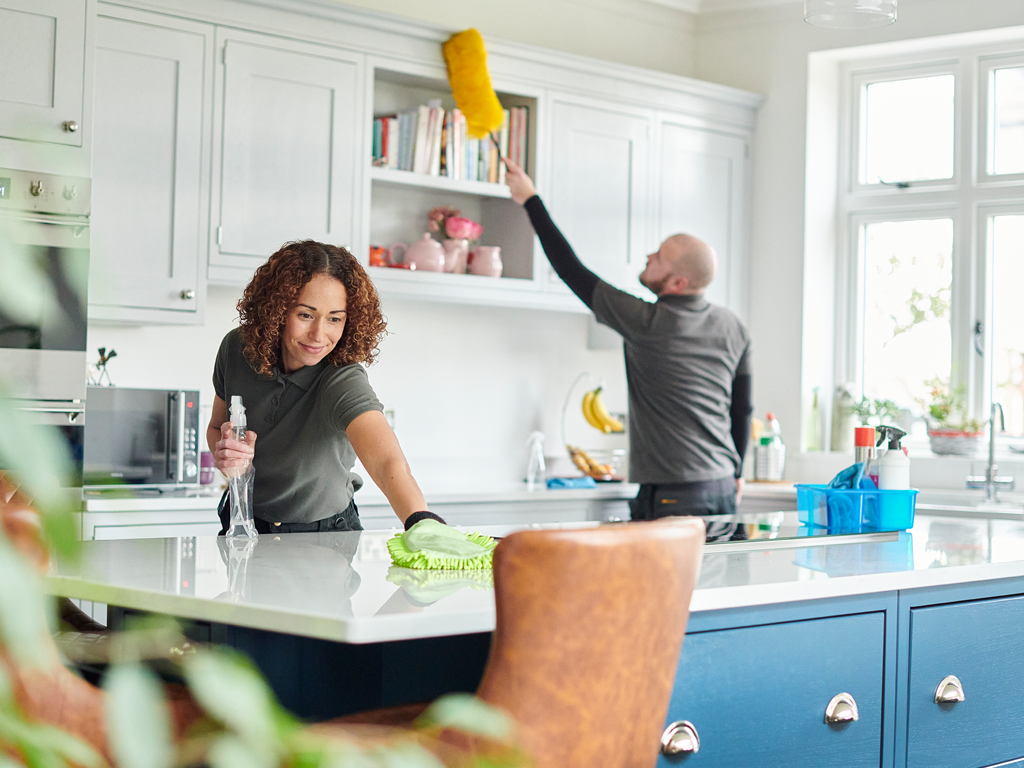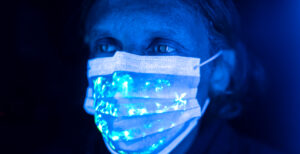Your kitchen is filthy. It doesn’t matter if you are a billionaire with a full-time cleaning staff or a holistic new-ager living in a cabin in the woods. Bacteria and fungi cover every surface in your kitchen (including you). Here are 6 surprising ‘micro’ facts to consider during your kitchen cleaning routine.
1. Most Surface Microbes Come from Your Skin
If you want to know where surface microbes come from, you needn’t look any further than your own skin. Human skin is home to about 1,000 species of bacteria, many of which help protect us from more dangerous pathogens. “As we touch surfaces around our home and shed skin cells, some of these helpful bacteria (along with other microbes) spread to home surfaces.”
The contribution from our skin is more significant than seemingly more obvious sources. For instance, a study of South Korean households found that 51% of our skin microbiome is also found on toilet seats (compared with only 15.4% of the human gut microbiome). A 2016 study of American kitchens found that “Human skin was the primary source of bacteria across all kitchen surfaces” with foodborne bacteria only “dominating in a few specific locations.”
2. Some Surface Microbes May Be Beneficial
Partially because of their symbiotic source, most surface microbes aren’t as scary as they seem. Only a handful of common microbes are opportunistic pathogens; some are even beneficial. According to a summary of recent publications in Medical News Today, “studies in animal models have shown that exposure to some viruses, bacteria, and parasites is linked to lower rates of allergy.” For instance, the bacteria Faecalibacterium prausnitzii may be “‘anti-inflammatory and protective against Crohn’s disease.’’ Meanwhile, “Exposure to microorganisms in raw milk and those in the dust of homes located on farms has been strongly implicated in lower allergy rates.”
To be clear, we are not advising that you go around shoving dust up your nose while downing gallons of unpasteurized milk. The point is that not every surface microbe is out to make you sick. Some may even be essential for a well-balanced immune system.
3. Cleaning Frequency Is Key
Even if they aren’t dominant, potentially pathogenic bacteria are found throughout the kitchen. An insightful paper from Cardiff Metropolitan University points out a troubling conundrum — older adults are more susceptible to foodborne illnesses “as a result of age-associated decrease in immunity, gastrointestinal tract changes, excessive antibiotic usage, malnutrition, and sedentary lifestyles.” Sampling the kitchens of 100 older adults, the study found that their cleaning routines made a difference. Those who reported cleaning the refrigerator more frequently had lower rates of Enterobacteriaceae, Staphylococcus aureus, and Listeria species in said fridge. Elderly adults who lived alone also tended to have more contaminated hand towels, suggesting that frequent laundering could also help. In other words, taking cleaning seriously (but not obsessively) can reduce exposure to potentially harmful pathogens on surfaces.
4. Don’t Clean Surfaces with Your Dish Sponge
Unsurprisingly, the least frequently cleaned surfaces tend to have the most diverse bacterial communities. For instance, the previously mentioned study of American kitchens found the largest variety of bacteria on stove exhaust fans. Diversity, however, doesn’t necessarily mean more harmful pathogens or more biomass. In fact, the areas you clean more frequently may have the most virile germs. Areas around the sink tend to harbor microbes capable of forming colonies. What might cause this odd contrast? We suspect it’s what you are cleaning with.
Like every living thing, bacteria and fungi need food, water, and shelter. All of these can be found in your kitchen dish sponge; there they can safely munch leftover food particles in a warm and wet Shangri La. At least 3 studies we read found that dishwashing equipment had the highest microorganism count. (Other microbial paradises in your house include pet dishes, sinks, toothbrush holders, and refrigerator drawers.) As one Texas study put it, “Over half of parents in the present study reported the use of dish sponges to clean the kitchen counter, which due to the high number of observed unique foodborne pathogens identified, is a behavior that may elevate cross-contamination risk.” So, skip the sponge and use a separate rag instead.
5. Hygiene Is Even More Important Than Cleaning
Basic hygiene is far more essential than scrubbing every surface. A sampling of Philadelphia kitchens found that “The contamination of surfaces with fecal coliforms and S. aureus was significantly associated with a lack of cleaning materials: dish soap and paper or cloth towels in the kitchen, and any type of towel in the nearest bathroom.” In other words, (we can’t believe we have to say this) you need to wash your hands between going to the bathroom and preparing food. Having the supplies ‘on hand’ to do this makes it easier to remember.
In the spirit of hammering home the obvious, you also need to wash your hands after you handle raw food. Per the aforementioned 2016 paper, “The relative abundance of Campylobacter[…]was greatest on surfaces above counter tops, including upper cabinet handles and the microwave panel[…]Because Campylobacter contamination in kitchens is typically attributed to raw poultry[…]one possible explanation for these patterns is that contamination occurred from the hands of an individual who had handled raw poultry.”
6. Individual Immune Systems Matter
Dangerous foodborne illnesses aside, the most important thing about surface microbes is how they affect you as an individual. To quote Medical News Today, “[…]among the plethora of microorganisms that inhabit our homes and living spaces, some are friends and some are foes[…]how we react to particular microbes depends on our individual immune systems.” Many people don’t have much to worry about from surface microbes if they practice basic hygiene and food safety.
However, there are those who might want some extra help: the elderly, the immuno-compromised, and those with severe allergies or asthma. If you are struggling to keep surfaces clean enough for your individual wellness, your first call should be to your doctor. After that, though, feel free to call us. ActivePure’s new Guardian Air Home is a whole-house, triple-layered solution to address pathogens in the air and on surfaces. We can’t replace your cleaning routine, but we can give it a helping hand. Learn more about the Guardian Air Home below.



